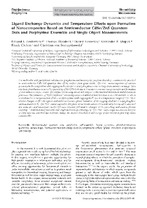Ligand dynamics and temperature effects upon formation of nanocomposites based on semiconductor CdSе/ZnS quantum dots and porphyrins: ensemble and single object measurements

Date
2012Bibliographic entry
Ligand dynamics and temperature effects upon formation of nanocomposites based on semiconductor CdSе/ZnS quantum dots and porphyrins: ensemble and single object measurements / E. I. Zenkevich [et al.] // Macroheterocycles. – 2012. – Vol. 5, № 2. – P. 98-114.
Abstract
Dye molecules with pyridyl side substituents (porphyrins and heterocyclic perylene diimides) coordinatively attached to semiconductor CdSe/ZnS quantum dots (QDs) surface form quasi-stable “QD-Dye” nanocomposites of various geometry in the competition with capping molecules (tri-n-octyl phosphine oxide or long chain amines) exchange. This results in photoluminescence (PL) quenching of the QDs both due to Foerster resonance energy transfer and formation of non-radiative surface states. QD surface is inhomogeneous with respect to the involved attachment and detachment processes. The formation of “QD-Porphyrin” nanocomposites is realized at least two time scales (60 and 600 s), which is attributed to a reorganisation of tri-n-octylphosphine oxide capping shell. In a low temperature range of 220÷240 K related changes in QD absorption and emission reveal a phase transition of the capping shell (tri-n-octyl phosphine oxide and amine). In “QD-Dye” nanocomposites, this phase transition is enhanced considerably by only a few attached dye molecules and has impact on the QD core structure followed by changes of PL quenching and exciton-phonon coupling. A combination of ensemble and single molecule spectroscopy of “QD-Dye” nanocomposites reveals that few or even only one attached dye molecule change the surface distribution and energy of dye related surface trap states considerably.
